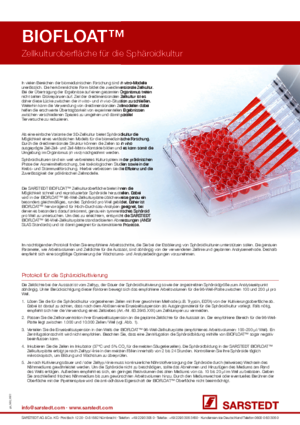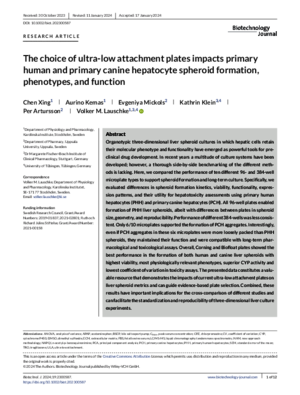
BIOFLOAT™ - The anti-adhesive surface for spheroid culture
BIOFLOAT™ - The anti-adhesive surface for spheroid culture
Language:
Some of the data collected by this provider is for the purposes of personalization and measuring advertising effectiveness.
We do not use cookies of this type.
Some of the data collected by this provider is for the purposes of personalization and measuring advertising effectiveness.
Some of the data collected by this provider is for the purposes of personalization and measuring advertising effectiveness.
We do not use cookies of this type.
The new BIOFLOAT™ cell culture surface for spheroid culture features a high-grade anti-adhesive property. This makes it possible for the cultivated cells to form primarily cell-cell contacts without adhering to the surface of the vessel. BIOFLOAT™ thus makes it possible for you to produce perfect spheroids quickly and reproducibly.
BIOFLOAT™ is used in a variety of fields of biomedical research such as cancer and stem cell research, in the preclinical phase of drug research and in toxicological studies. The efficiency and reliability of preclinical cell models are improved for these applications.

The technical drawing can be found under the “Technical Information” tab.
The initial cell count selected depends on the cell type/cell line and the desired size of the spheroids. Experience has shown that cell counts between 1,000 and 6,000 cells/well are suitable. To set the cell count per well for the respective experiment, it is recommended to carry out a dilution series and then determine the optimal cell concentration based on the desired parameters.
A centrifugation step is not recommended. Unnecessary centrifugation can even have a negative effect on spheroid formation. However, if you wish to centrifuge the cells at the start anyway, 200-300 x g for 2-5 min. should not be exceeded.
The time required by the cells to form spheroids depends on the cell line. With BIOFLOAT™, formation has been observed after 2-24 h. It should be noted that some cells first form only loose aggregates that become increasingly dense over time, so the diameter of the spheroid may first become smaller in this initial phase.
Not all cell lines or cell types are equally suitable for forming spheroids. It may be helpful to add proteins of the extracellular matrix to make spheroid formation possible.
The maximum possible period for spheroid culture depends on the cell line. Cells have been cultivated continuously for more than 80 days in the BIOFLOAT™ 96-well plate.
Spheroids, which usually consist of one or maximum two cell types/lines, should not be confused with organoids, which are more complex 3D cell cultures. The formation of organoids is a complex process that cannot be reproduced in the BIOFLOAT™ plate alone. However, previously formed organoids have been successfully cultivated in the BIOFLOAT™ plate.
The BIOFLOAT™ surface is very robust against mechanical effects caused by pipetting. It is thus no problem to change the medium in the plate several times.
We would like to show you additional content which is hosted by a third party. For this purpose we need your consent to set cookies:


Please select your location, so that we can show you the product range relevant to your country / region.
